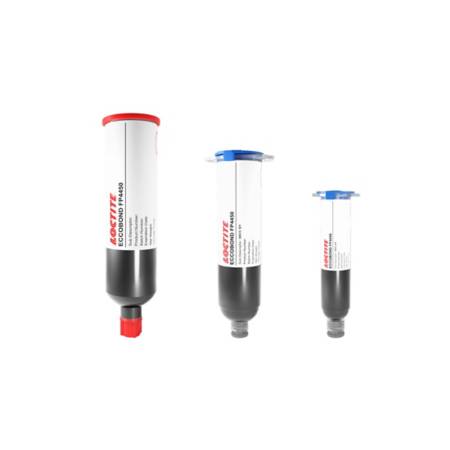LOCTITE ECCOBOND FP4450HF
- Excellent corrosion resistance
- Low filler size
- Self levelling - Low alpha
Product Description
LOCTITE® ECCOBOND FP4450HF Fill encapsulant is designed for protection of bare semiconductor devices. Autoclave performance on live devices is greater than 1,000 hours with no failure, depending upon device and package type. The use of synthetic fused silica yields very low alpha particle emissions suitable for memory devices. A cavity or potting dam is required for flow control.
LOCTITE® ECCOBOND FP4450HF is a higher Tg version with a much lower filler cut size of 25um. It is admittedly a better product than FP4450, but much newer and therefore comes in lower package volumes and the price is slightly higher. Moisture uptake is expected to be comparable to FP4450. Its fine filler size, along with the lower viscosity make it indeed a "HF" High flow product.
Recommended Cure Schedule
- 30 minutes @ 125°C plus
- 90 minutes @ 165°C
Technical Specifications
| General Properties | |||||||||
| Filler Content | 73 % | ||||||||
| Pot Life Pot Life Pot life is the amount of time it takes for the viscosity of a material to double (or quadruple for lower viscosity materials) in room temperature after a material is mixed. It is closely related to work life but it is not application dependent, less precise and more of a general indication of how fast a system is going to cure. | 96 hours | ||||||||
| Specific Gravity Specific Gravity Specific gravity (SG) is the ratio of the density of a substance to the density of a reference substance; equivalently, it is the ratio of the mass of a substance to the mass of a reference substance for the same given volume. For liquids, the reference substance is almost always water (1), while for gases, it is air (1.18) at room temperature. Specific gravity is unitless. | 1.79 | ||||||||
| |||||||||
| Thermal Properties | |||||||||
| Glass Transition Temperature (Tg) Glass Transition Temperature (Tg) The glass transition temperature for organic adhesives is a temperature region where the polymers change from glassy and brittle to soft and rubbery. Increasing the temperature further continues the softening process as the viscosity drops too. Temperatures between the glass transition temperature and below the decomposition point of the adhesive are the best region for bonding. The glass-transition temperature Tg of a material characterizes the range of temperatures over which this glass transition occurs. | 164 °C | ||||||||
| |||||||||
| |||||||||
| Other Properties | |||||||||
| MSL Level | MSL 3 | ||||||||
| Mechanical Properties | |||||||||
| |||||||||
| |||||||||
| Chemical Properties | |||||||||
| |||||||||
| Physical Properties | |||||||||
| Viscosity Viscosity Viscosity is a measurement of a fluid’s resistance to flow. Viscosity is commonly measured in centiPoise (cP). One cP is defined as the viscosity of water and all other viscosities are derived from this base. MPa is another common unit with a 1:1 conversion to cP. A product like honey would have a much higher viscosity -around 10,000 cPs- compared to water. As a result, honey would flow much slower out of a tipped glass than water would. The viscosity of a material can be decreased with an increase in temperature in order to better suit an application | 32,000 mPa.s | ||||||||
Additional Information
How does this product fare compared to the rest of the close FP family?
FP 4450HF resin system is closest to 4450 and we can consider 4450HF as smaller filler particle size version of 4450 (
We have internal information showing that these legacy semiconductor liquids pass UL94HB at 1/8” thickness but do not have the test data or yellow card nor are we going to test for it. This is anecdotal but, hopefully, helpful.

No available data for Dielectric strength. According to our scientists a highly silica filled encapsulant will have a range of 20 to 40Kv/mm.




